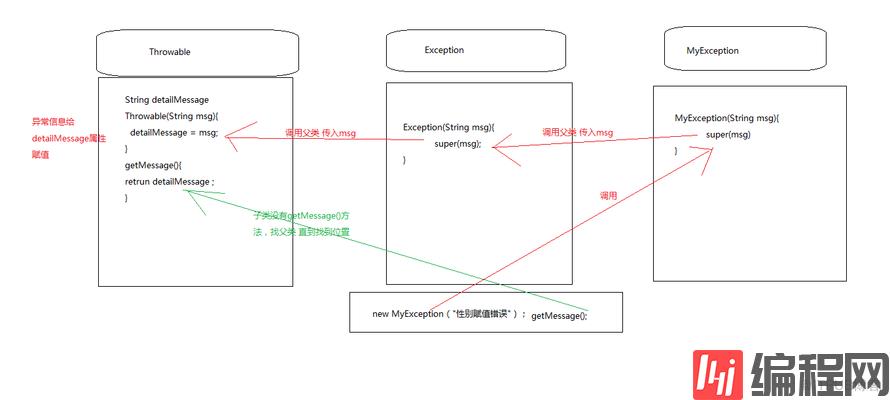![JAVA异常处理方式是什么 JAVA异常处理方式是什么]()
这篇文章主要讲解了“JAVA异常处理方式是什么”,文中的讲解内容简单清晰,易于学习与理解,下面请大家跟着小编的思路慢慢深入,一起来研究和学习“JAVA异常处理方式是什么”吧!
1:try-catch
结构:
* 结构:
* try{
* 可能出现异常de代码段
* }catch(可能出现的异常){
* 解决办法
* } |
顺序:
* try-catch的执行顺序:
* 1、执行try块中的代码块 如果出现异常
* 2、通过出现的异常去匹配 catch中声明的异常类型
* 3、如果匹配成功 执行catch中的代码块 如果匹配失败 jvm处理当前异常信息 (终止程序 输出异常信息)
* 4、继续执行剩下的代码 |
例子:
public class Test04 { public static void main(String[] args) { try{ int num = 1/0;//new ArithmeticException() System.out.println(num); }catch(InputMismatchException e){ //InputMismatchException e = new ArithmeticException(); System.out.println("除数不能为0"); } System.out.println("嘿嘿"); } }
|
注意事项
2:try-多重catch
结构:
* 结构:
* try{
* 可能出现异常的代码
* }catch(异常类型1 e1){
* 解决方案1
* }catch(异常类型2 e2){
* 解决方案2
* }catch(异常类型3 e3){
* 解决方案3
* }。。。。{
* } |
顺序
* 执行顺序:
* 1、执行try块 如果出现异常
* 2、以此匹配多重catch中声明的异常
* 3、如果匹配成功 执行当前匹配成功的catch块 try-catch块执行完毕 继续执行下面的代码
* 4、如果匹配失败 交由jvm处理 程序终止 输出异常信息
* 5、一般情况下我们都会在最后一个catch中加入Exception 获取可能没有捕获的异常信息 |
例子
public class Test05 { public static void main(String[] args) { Scanner input = new Scanner(System.in); try{ System.out.println("请输入被除数---->"); int num1 = input.nextInt(); System.out.println("请输入除数---->"); int num2 = input.nextInt(); System.out.println(num1+"/"+num2+"="+(num1/num2)); }catch(InputMismatchException e){//这个异常对象中没有维护异常的原因 所以通过getMessage获取不到异常信息 null值 //e.printStackTrace(); System.out.println(e.getMessage()); System.out.println("用户输入有误"); }catch(ArithmeticException e){//这个异常对象中维护异常的原因 所以通过getMessage可以获取到异常信息 System.out.println(e.getMessage());//by zero System.out.println("除数不能为0"); }catch(Exception e){//Exception e = new 可能出现的异常(); 父类变量指向了子类对象 //多态 System.out.println(e.getMessage()); System.out.println("外星人把页面叼走了 请等待。。。"); } } }
|
注意事项:
PS:
一般情况下我们都会在最后一个catch中加入Exception 获取可能没有捕获的异常信息 常见的异常的对象中的方法:
* 异常中常见的方法:
* e.getMessage() -->获取异常的原因藐视
* e.printStackTrace() -->打印异常的出现行数以及异常的全限定名* e.toString --> 异常的全限定名 |
3:try-多重catch-finally
结构:
* 结构:
* try{
* 可能出现异常的代码
* }catch(异常类型1 e1){
* 解决方案1
* }catch(异常类型2 e2){
* 解决方案2
* }catch(异常类型3 e3){
* 解决方案3
* }。。。。{
* }finally{
* 代码块
* } |
顺序:
* 执行顺序:
* 1、执行try块 如果出现异常
* 2、以此匹配多重catch中声明的异常
* 3、如果匹配成功 执行当前匹配成功的catch块 执行finally代码块 try-catch-finally块执行完毕 继续执行下面的代码
* 4、如果匹配失败 交由jvm处理 程序终止 输出异常信息 也会执行finally代码块
* 5、一般情况下我们都会在最后一个catch中加入Exception 获取可能没有捕获的异常信息
* 6、一般情况下通过finally去关闭连接资源 |
例子:
public class Test06 { public static void main(String[] args) { Scanner input = null; try{ input = new Scanner(System.in); System.out.println("请输入被除数---->"); int num1 = input.nextInt(); System.out.println("请输入除数---->"); int num2 = input.nextInt(); System.exit(0);//关闭虚拟机 0正常退出 非0 强制退出 System.out.println(num1+"/"+num2+"="+(num1/num2)); }catch(InputMismatchException e){ System.out.println("用户输入有误"); }catch(ArithmeticException e){ System.out.println("除数不能为0"); }catch(Exception e){ System.out.println("外星人把页面叼走了 请等待。。。"); }finally{ System.out.println("我被执行了"); //在这里关闭的 input.close(); } } }
|
注意事项:
| PS: |
finally一定会被执行 return 以及异常或者是正常情况下都会执行finally代码 System.exit(数字) 退出虚拟机 0 正常 非0 强制
|
4:throws 声明一个异常
语法格式:
* 注意格式:
* 方法() throws 异常类型1,异常类型2。。。{} |
注意事项:
s不要忘记 一个方法可以声明多个异常信息 某个方法如果对外声明一个异常,那么调用者一定要解决当前异常。解决方案:
A、try-catch B、继续向外声明 |
案例:
public class Test08 { public static void main(String[] args)throws Exception { System.out.println(add(1,43)); } public static int add(int num1,int num2)throws Exception{ return num1+num2; } }
|
5:throw抛出异常信息
语法格式:
throw new 异常类型();
PS:抛出异常是在方法内部编写的 |
注意事项:
throw 抛出异常在方法体体编写 一般情况下和throws一起使用
|
案例:
public class Test09 { public static void main(String[] args) { //1、创建一个user对象 User u = new User(); //2、解决异常 try { u.setGender(12);//new Exception(); } catch (Exception e) { e.printStackTrace(); } } } class User{ private int gender; public User() { // TODO Auto-generated constructor stub } public int getGender() { return gender; } public void setGender(int gender) throws Exception{ //判定gender的值 if(gender==0||gender==1){ this.gender = gender; }else{ //抛出一个异常 throw new Exception(); } } }
|
6:自定义异常:
自定义异常的步骤:
* 如何自定义异常:
* 1、创建一个类 让当前类要么继承Exception 要么继承RuntimeException
* 2、编写当前类的构造器 :
* a、一定要写空构造器
* b、一定要写一个带异常原因描述的构造器 (带一个String参数的构造器)
* 3、在构造器内部通过super()调用父类的构造器即可 |
自定义异常如何获取异常信息:类图:
![JAVA异常处理方式是什么]()
实例:
public class GenderException extends Exception{ public GenderException(){ } public GenderException(String str){ super(str); } }
|
测试类:
public class Test11 { public static void main(String[] args) { //1、创建一个Person对象 Person p = new Person(); try{ p.setGender(10); }catch(GenderException e){ System.out.println(e.getMessage()); } System.out.println(p.getGender()==0?"女生":"男生"); } } class Person{ private int gender; public Person() { // TODO Auto-generated constructor stub } public int getGender() { return gender; } public void setGender(int gender) throws GenderException,NullPointerException{ if(gender==0||gender==1){ this.gender = gender; }else{ //抛出异常 throw new GenderException("性别赋值错误"); } } }
|
PS:当int作为属性时它是具有默认值,默认值是0.而这个值有可能导致程序运行期间出现不稳定因素
感谢各位的阅读,以上就是“JAVA异常处理方式是什么”的内容了,经过本文的学习后,相信大家对JAVA异常处理方式是什么这一问题有了更深刻的体会,具体使用情况还需要大家实践验证。这里是编程网,小编将为大家推送更多相关知识点的文章,欢迎关注!
免责声明:
① 本站未注明“稿件来源”的信息均来自网络整理。其文字、图片和音视频稿件的所属权归原作者所有。本站收集整理出于非商业性的教育和科研之目的,并不意味着本站赞同其观点或证实其内容的真实性。仅作为临时的测试数据,供内部测试之用。本站并未授权任何人以任何方式主动获取本站任何信息。
② 本站未注明“稿件来源”的临时测试数据将在测试完成后最终做删除处理。有问题或投稿请发送至: 邮箱/279061341@qq.com QQ/279061341

















